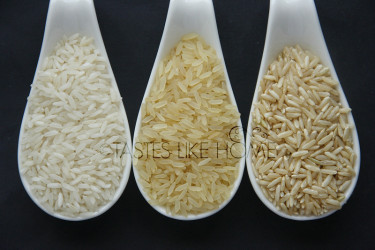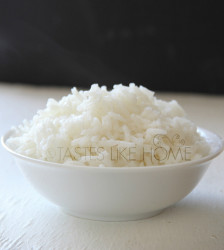Hi Everyone,
I have found over the years that many people are shy to ask certain questions about food and cooking that they think are too obvious or silly. I have decided to start this series, What’s Cooking. From time to time, I’ll do a What’s Cooking section to answer some of the questions you have, but are too shy to ask.
 For us, cooking rice is a daily ritual, and while there are different ways to cook up the grains, the most frequent method we employ is boiling. The boiling of rice is sometimes referred to as the pasta method and that’s because the approach is similar – a large pot of water is brought to a boil, the ingredient added and cooked to the desired texture.
For us, cooking rice is a daily ritual, and while there are different ways to cook up the grains, the most frequent method we employ is boiling. The boiling of rice is sometimes referred to as the pasta method and that’s because the approach is similar – a large pot of water is brought to a boil, the ingredient added and cooked to the desired texture.
The first meal I ever cooked (while still in single digit-age) was pork curry with boiled rice. Funny enough, the pork curry was the easier of the two dishes to cook; it was the boiling of the rice that had my siblings and me playing what I referred to as the counting game. The difficulty lay in determining when the rice was finished cooking. Once the rice was washed and added to the pot of boiling water where it shortly came to a tumbling roll Pat, Eon and I sat on the counter, stood on a chair and gazed into the pot. Being the eldest, I took charge and instructed that we would each (separately) count from one to a hundred, at which time, I would test the rice to see if it was done cooking. I think we totalled a thousand in our count but the rice was still not done cooking. Uncertainty then set it, counting was abandoned, and every couple of minutes I kept removing a few of the grains and pressing them against the pot spoon as I had seen my mom do so often. The rice was a little overcooked by the time I strained it but at least it did not turn into pap, so we were able to eat it with the curry.

Different types of rice are best suited to certain cooking methods but today we will focus exclusively on boiling rice. All types of rice – red, white, black, brown – can be boiled; some will cook up faster than others depending on the variety and age. There are over 40,000 varieties of rice that fall under each of the major types mentioned. For example, under the category of white rice we can find Jasmine, Basmati, long grain white, short grain white, and Arborio to name but a few; and under each of those categories, we can find even more varieties based on their manufacture. In some ways it can get quite complicated.
Let’s get down to the actual cooking (boiling of the rice). The degree of doneness or tenderness is something that is based on personal preference. Just like pasta, rice can be cooked al dente (firm, with a bite to it) or it can be cooked tender but not so soft that it turns to mush.
Start by bringing a large pot of water to boil. The pot should have enough room for the rice to move freely and easily as it bobs and rolls around in the liquid while expanding. A properly cooked grain of rice usually triples in size when compared with raw. By extension, 1 cup of raw rice usually yields 3 cups of cooked rice.

Wash or rinse the rice to remove some of the starch, which will result in the grains not clumping too much when cooked and cooled. Washing rice is also a cultural thing; while there is packaged rice that boasts of going directly from the packet to the pot, I still rinse my rice because the rice was packaged in a large warehouse somewhere and it eases my mind to know that I have washed my rice. In many places such as Guyana, where rice is sold in bulk from large crocus bags, the rice should be washed as some people tend to ‘turn up’ the rice to test the quality and besides it would be open to various elements in the atmosphere.
Drain the washed rice well and add it to the pot of boiling water. Add a little salt, not to taste but just a little to take the edge off the rawness of the rice and to give it a little flavour. Adding the salt is optional and I don’t know about you but I can tell when salt has not been added to boiled rice, it has a taste that I find off-putting.
Let the pot come to a boil, you can start it off on high heat and then reduce the heat to medium. Do not cover the pot as it can froth and boil over. A key point here is to ensure that at the onset, you have added enough water to the pot to cook the rice without having to add more water as the rice absorbs the liquid to cook. This is a mistake that a lot of people make and to “correct” the situation, they end up adding cool tap water which cools down the entire pot of rice which results in the rice taking in more water as it waits to come back to a boil. The result is sometimes overcooked, flavourless rice because it has absorbed too much water, or rice that is soft on the outside and hard on the inside. If you must add more water to the pot, then add boiling water from a kettle or something so that there is not a drop in temperature in the pot.
Make boiled rice appealing by flavouring the water when it comes to a boil (before you add the washed rice). Ingredients such as fresh lime leaves, bay leaves, bruised lemongrass stalks, whole cinnamon sticks, whole cloves, whole cardamom pods, fresh curry leaves, or citrus zest make excellent scented rice.
To test if the rice is cooked to your satisfaction, you can do it one of two ways – remove a few of the grains and press them against the pot spoon or between your thumb and index finger or (and I prefer this method), chew a few of the grains. I prefer the latter method because that is going to be the way that the rice will be consumed anyway.
Drain the rice well in a colander. There is absolutely no need to rinse the rice with cold water to cool it down and in the process wash away the essence of the flavour of the rice. Lift the colander and heave it up and down a few times to remove the excess moisture and then let it rest for about 10 minutes before tilting the lot back into the pot and serving. Remove the leaves and spices before serving (if you used any); they’ve done their job.
If you have a question that you would like addressed in What’s Cooking, email me: Cynthia@tasteslikehome.org
Cynthia









